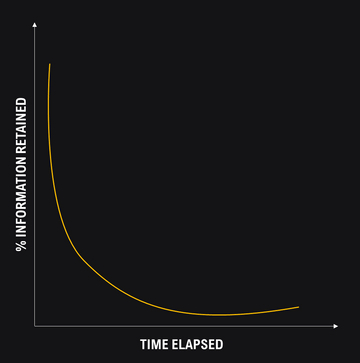L&D Strategy For Learner Attention Spans
One of the biggest challenges for Learning and Development (L&D) teams and instructors, be it in a classroom or an office training room, is the diminishing learner attention span. For this article, we will restrict ourselves to workplace learning and employee training programs and suggest some of the possible L&D strategies and tools that can be used to make digital learning engaging and effective. We will also look at the Ebbinghaus forgetting curve and the myth of the goldfish attention span theory, and see how spaced learning works as an effective solution to counter the distractions that plague modern workplace learning.
The Ebbinghaus Forgetting Curve And Its Relevance In Modern Workplace Learning
Have you ever wondered why we forget the things that we learn? Or why some people have a better retention of things that they learn? These two fundamental questions led German psychologist Hermann Ebbinghaus to conduct experiments and come up with a theory that is known as the “forgetting curve.” Some of the key findings of his research are listed below:
- Memories weaken over time
- One tends to forget key elements of what one has learnt immediately after the training is completed
- One tends to remember things that one likes or subjects that one has an affinity for
- Presentation of learning content has an impact on how much one remembers
- Physical and emotional health of the learner plays a key role in the retention of learning
Ebbinghaus Forgetting Curve
Though Ebbinghaus’ research dates to the 1880s, its findings are significant and are relevant even today. Workplace learning has changed in the last couple of years because of the pandemic-induced lockdowns. Work from home, remote work, and hybrid working models have now brought in additional distractions for learners. L&D teams have to adopt several measures to ensure that learners have a distraction-free and engaging learning experience. The next section will look at some of the tips and tricks that L&D experts can use to make workplace learning a rewarding experience.
Making Digital Learning An Engaging Experience
Here are some suggestions for L&D teams to make digital learning engaging and interesting for learners irrespective of them accessing learning from home or at work.
1. Games
Gamification of learning is one of the best ways to improve learner engagement. A thoughtfully designed game or an interactive quiz boosts retention of learning and helps learners recollect the core concepts of the course.
2. Microlearning
In another article, we have examined how microlearning works as an effective learning strategy in workplace learning and the different training scenarios where it can be used for the proper dissemination of learning [1]. Microlearning groups together learning into smaller units and focuses on a specific learning objective in each microlearning module. This makes learning easier, and the shorter running time of each microlearning module allows the learners to devote their full attention to the module.
3. Learning Nudges
When in school, our teachers and our parents would ask us to keep reading aloud from our text books, or to copy out passages from storybooks on a regular basis, this would help us remember the lessons easily. A similar concept, known as learning nudges, can be applied in workplace learning. Learners can receive notifications on their smartphones. It could be an SMS, a WhatsApp message, or an email with a link to a lesson. Learning nudges reinforce learning of core concepts and are a great way to foster learning at the workplace.
4. Spaced Learning
Spaced learning is a popular concept used in teaching that can be used to good effect in workplace learning as well [2]. Essentially, a longer learning course is broken into smaller learning units and divided into sessions of short duration with adequate breaks. The learning content is repeated and the learners are made to participate in activities that assess them on the concepts taught in the course. Thus spaced learning is dependent on breaking a longer course into smaller learning chunks and repeating the core concepts of the course multiple times.
5. Rewards And Recognition
One of the core behavioral aspects of human nature is the need to feel recognized for one’s efforts and being appreciated for one’s deeds. Workplace learning can be made more interesting and effective by rewarding and recognizing successful employees who complete their training on time and complete the prescribed assessments with a good score. L&D can incorporate digital badges and certificates, which learners can share on their LinkedIn profiles. Announcements can be made on company intranets and akin to “employee of the month” awards there can be “learner(s) of the month” awards. Employees can also be rewarded with actual gift coupons or shopping vouchers, which they can use to buy things that they want.
6. Personalized Learning Paths
Each employee is unique, with a different set of skills and learning requirements. Doing a thorough skill analysis of each employee and then creating a customized or personalized learning path with a course structure that is relevant to their job-role or prepares them for a new role, instead of using an “off-the-shelf” or “catalog-course”, is another way to ensure better retention of learning and improving learner engagement.
6. Scenario-Based Learning
Scenario-based learning is another strategy that is used to increase the active participation of learners in workplace training programs [3]. Incorporating elements of role play, learners are given different scenarios and asked to solve problems by applying the concepts that they have learnt in the training program. This gives the learners an opportunity to understand the real-world problems and scenarios when handling an issue, and prepares them to face such challenges in their daily work routine. This works really well in sales and customer care training programs, and prepares support staff to handle customer complaints and client escalations effectively.
References:
[1] Does Microlearning Really Work in Corporate Learning?
[2] What is Spaced Learning – Learn Anything Faster!

S4Carlisle Publishing Services
We bring the right mix of pedagogy and andragogy, instructional creativity, content, and apt use of new-age technology to deliver high-quality solutions to meet your learning and training needs.
Originally published at www.s4carlisle.com.


